We do it every day, and so automatically we barely even think about it. It’s breathing, the process of taking in air by inhaling, and letting it out by exhaling. But really, it’s so much more than that.
Deep breathing, relaxation breathing, breathwork, or any of the other names it is known by, is almost like a relaxation super-power which, when practiced, offers kids (and adults) numerous benefits and improved physical and mental wellbeing.
Focusing on the breath is an intrinsic part of most meditative practices. But for many kids, and even adults, the instruction ”focus on your breath” is vague and confusing.
Let’s dive in to learn more about the benefits of deep breathing for kids and some easy ways we can teach it to little ones as part of a daily mindfulness practice.
Taking slow, deep breaths has a lot of benefits. It calms the mind and the body because it activates the parasympathetic nervous system. The parasympathetic nervous system is part of your autonomic nervous system and its job is to relax, and reduce, your body’s activities. When you take slow, deliberate breaths you send your body a message to slow down and relax.
Deep breathing exercises are a wonderful way to reduce anxiety and bring attention to the present moment. It is also a great way to distract kids from anxious thoughts, and the benefits are threefold. One, kids calm down physically by taking the slow breaths. Two, when kids focus on breathing it becomes a mental distraction from anxiety and worry. And, three, by making slow deep breathing a part of each day, kids get the cumulative benefits of breathwork, which increase with time and repetition.
Because deep breathing has so many benefits, it should be part of a child’s calm-down toolbox. Research has shown that even children with asthma greatly benefit from relaxation breathing techniques.
Once kids have the hang of relaxation breathing, they can use the practice anytime, anywhere to calm anxiety, soothe, and reset when they feel overwhelmed or ease themselves into sleep. Another bonus from breathwork is that it can be done anytime and anywhere, without drawing any attention to themselves. Kids can do it before a big test, when riding the school bus, or before a big performance.
Oftentimes in meditation the instruction is given to focus on your breath. Since kids can’t really see their breath, unless they are breathing outside on a very cold day, breath is invisible to them, making the concept abstract and hard to follow. The good news is there are many fun ways to specifically teach breathing exercises to kids.
Here are several creative ways to teach kids how to focus on their breath. By implementing any or all of these ways kids will become more connected to their breath, attuned to their body, and feel more calm and peaceful.
Taking belly breaths is an easy way to get kids doing relaxing, diaphragmatic breathing, while also teaching them the way their breath moves in their bodies.
Rainbow breaths use the same technique as belly breaths, called diaphragmatic breathing. But in rainbow breaths your child imagines breathing in the color of a rainbow with each inhale. If your child is comfortable, have them close their eyes.
Doing a rainbow meditation, imagining breathing in every color of the rainbow (red, orange, yellow, green, blue, indigo and violet) is a wonderful way for kids to get calm and relaxed, wherever they are.
The earlier you start teaching little ones deep breathing exercises, the sooner they will feel the benefits.
Toddlers may not be able to understand belly breathing, but you can show them how to slow down their breathing when they are angry, afraid, or having other big emotions. Preschoolers and school-aged kids might learn the techniques more easily, but with calming practice sessions over time, any child can learn to take relaxation breaths.
One fun way to do this is with a stuffed animal or a puppet. You can do a mini skit where the puppet is angry or upset and they take slow, deep breaths to calm down. Little ones love puppets, or when parents bring a favorite stuffed animal to life, and using their favorite lovey to teach relaxation breathing is a wonderful way to start.
When teaching deep breathing exercises, or anything else, remember that kids learn best when they are calm and relaxed. When kids are feeling good mentally and physically they are receptive to learning new things. Then, when they are feeling anxious and overwhelmed they will be ready and equipped to learn their new breathwork skills in the moment. Teaching kids new concepts when they are in the midst of big emotions means they won’t retain the information as easily, or be as likely to want to use their new skills in the future.
Before teaching relaxation breathing, have kids get calm and settle into their space. You might want to play soft music, diffuse a soothing essential oil, or wrap them in a cozy shawl or blanket.
Teaching children breathwork at bedtime is a wonderful way to enhance their nighttime routine and help them fall asleep quickly, and on their own. Since deep breathing exercises calm the parasympathetic nervous system, practicing right before they fall asleep is very beneficial.
Counting inhales helps kids learn to pace their breaths. Ideally it’s best to have a shorter inhale and a longer exhale, and counting helps kids do this. If your child is able to, have them breathe in through the nose for a slow count of three.
Your child may be able to breathe in for longer counts, and with practice, longer still. Breathwork abilities always improve with practice as lung capacity increases. It’s not as important how long their inhales and exhales are. The most important thing for them to learn is how to slow down their breathing, whatever that pace may be.
In all things, you know your child best. Some breathing exercises for kids will appeal to some children, but not others. That’s perfectly normal. You can adapt teaching deep breathing to your child in a way, and during the times, that work best for them. The main goal is for your child to feel comfortable and enjoy relaxation breathing. When your child enjoys relaxation breathing they will opt to use it on their own during times of stress or when they feel they need a calming break. When your child feels the benefits of taking calm breaths, it will likely become a go-to strategy they use often, and not just when they are meditating.
Want your child to benefit from deep breathing? Wee Meditate has a meditation library with hours of meditation and mindfulness audio stories. Our mini meditations playlist is the perfect way to introduce deep breathing to kids. Kids can listen and practice along with exercises like Warm Cup and Flower Breaths for easy and engaging ways to learn deep breathing techniques. Sign up today to get started!

